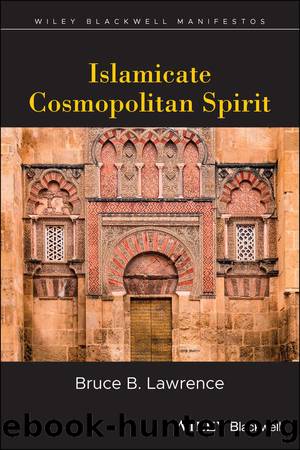Islamicate Cosmopolitan Spirit (Wiley-Blackwell Manifestos) by Bruce B. Lawrence

Author:Bruce B. Lawrence [Lawrence, Bruce B.]
Language: eng
Format: epub
ISBN: 9781118780008
Publisher: Wiley
Published: 2021-09-07T18:30:00+00:00
Notes
1âHis fame now extends to the Internet age. See Richard Feloni, âWhy Mark Zuckerberg Wants Everyone to Read the 14th Century Islamic Book âthe Muqaddimahâ,â Business Insider (June 2, 2015) at http://uk.businessinsider.com/mark-zuckerberg-the-muqaddimah-2015-6?r=US.
2âMana Kia, Persianate Selves: Memories of Place and Origin before Nationalism (Stanford, CA: Stanford University Press, 2020): 14.
3âAbbas Amanat, âRemembering the Persianateâ in Abbas Amanat and Assef Ashraf, The Persianate World: Rethinking a Shared Sphere (Leiden/Boston, MA: Brill, 2019): 34. âHindustanâ is the Persian name to describe the Indian subcontinent.
4âFor much of the analysis that follows, I am indebted to Richard M. Eaton and his deft exposition of Persianate antecedents, developments, and challenges in an article, âRevisiting the Persian Cosmopolis,â Asia Times (July 19, 2014). See http://www.atimes.com/atimes/South_Asia/SOU-01-190713.html, no longer extant but available at https://www.gcgi.info/blog/423-revisiting-the-persian-cosmopolis-the-world-order-and-the-dialogue-of-civilisations. The essay anticipates, and is now superseded by, Eatonâs recent monograph, India in the Persianate Age 1000â1765 (London: Penguin, 2019). This monograph is especially notable for its reassessment of south India at the intersection of two cosmopolises: Persian and Sanskrit: âa deeper trend in the Deccanâs cultural history, namely a progressive interpenetration of the Sanskrit and Persianate worlds between the fourteenth and sixteenth centuriesâ (pp. 457â458). Later, the great Mughals facilitated the formation of a transregional empire with the âcirculation of people along established transregional networks that connected key centres of Persianate cultural productionâ (p. 901). The denouement of the early modern period is also marked by literary indices: âBetween the mid eighteenth and the late nineteenth centuries, two great transregional languages, which for centuries had defined the Sanskritic and Persianate worlds, became artefacts in India, eclipsed in the north by new literary genres in dialects of spoken Hindavi â prominently Braj and Urdu. And yet, although the patronage of Sanskrit and Persian literature and the usage of the two languages receded dramatically, the values, sentiments and ideas sustained through their respective literary traditions had become deeply enmeshed over the course of nearly a millennium of mutual interactionâ (pp. 922â923). It is hard to imagine a more expansive narrative of the Persianate tradition in South Asia than Eaton here provides.
5âSee Eaton (2004) âRevisiting the Persian Cosmopolisâ cited above.
6âFor a further engagement with the stability and expansion of Persian literary conventions throughout eastern Islamdom, from the 9th to the 19th century, including China, see Brian Spooner and William L. Hanaway, eds., Literacy in the Persianate World: Writing and the Social Order (Philadelphia, PA: University of Pennsylvania Museum of Archaeology and Anthropology, 2012). On the basis of more than 30 years of archaeological and textual studies, Victor Mair concludes that: âthe Iranian peoples (i.e., speakers of Iranian languages) were the paramount Kulturvermittlers (culture brokers/transmitters) of Eurasia from the Bronze Age through the late medieval periodâ (p. 389). Not only was Persian prominent and the art of writing Persian preserved among Chinese Muslims but Persian continues to be taught in contemporary China (p. 404).
7âSaïd Amir Arjomand, âDefining Persianate Studies,â Journal of Persianate Studies I (2008), 3â4. I have omitted part of the defense of this new journal and altered the last sentence to clarify the authorâs intent.
Download
This site does not store any files on its server. We only index and link to content provided by other sites. Please contact the content providers to delete copyright contents if any and email us, we'll remove relevant links or contents immediately.
The History of Jihad: From Muhammad to ISIS by Spencer Robert(2572)
Nine Parts of Desire by Geraldine Brooks(2326)
The Turkish Psychedelic Explosion by Daniel Spicer(2314)
The First Muslim The Story of Muhammad by Lesley Hazleton(2219)
The Essential Rumi by Coleman Barks(1992)
1453 by Roger Crowley(1965)
The Last Mughal by William Dalrymple(1831)
Trickster Travels: A Sixteenth-Century Muslim Between Worlds by Davis Natalie Zemon(1815)
God by Aslan Reza(1614)
Muhammad: His Life Based on the Earliest Sources by Martin Lings(1607)
by Christianity & Islam(1595)
A Concise History of Sunnis and Shi'is by John McHugo(1547)
Magic and Divination in Early Islam by Emilie Savage-Smith;(1500)
No God But God by Reza Aslan(1493)
The Flight of the Intellectuals by Berman Paul(1463)
Art of Betrayal by Gordon Corera(1403)
Nothing to Envy by Barbara Demick(1387)
What the Qur'an Meant by Garry Wills(1363)
Getting Jesus Right: How Muslims Get Jesus and Islam Wrong by James A Beverley & Craig A Evans(1309)
